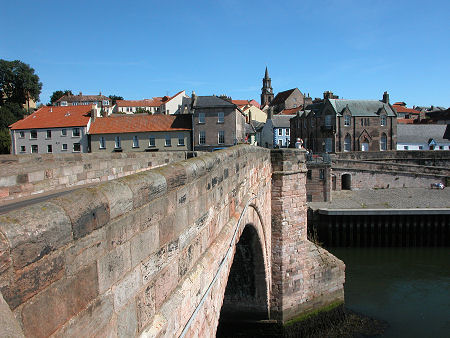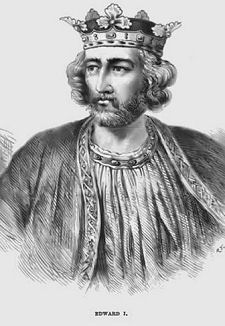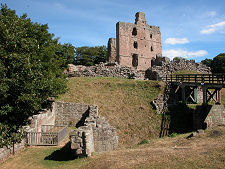 Berwick-upon-Tweed, Sacked by Edward I |
Edward I of England lived from 17 June 1239 to 7 July 1307 and he succeeded his father Henry III to the throne of England on 21 November 1272. Edward was known to many as Longshanks because at 6ft 2in or 1.88m he was unusually tall for his day. He had another nickname that explains his inclusion here. On his tomb in Westminster Abbey is inscribed Hic est Edwardus Primus Scottorum Malleus: "Here lies Edward, Hammer of the Scots." The wider picture in Scotland at the time is set out in our Historical Timeline.
On 1 November 1254 at the age of 15, Edward was married to Eleanor of Castile at the Monastery of Las Huelgas. He was also knighted by King Alfonso X of Galicia, Castile and León (Eleanor's half brother). In 1255 Edward and Eleanor returned to England, where Edward became embroiled in his father's power struggle with key English barons. Edward went as far as backing the barons, including Simon de Montfort while Henry III was in France.
Fearing that Edward was plotting against him, Henry III returned to England and the two were reconciled. The barons subsequently rebelled, and at the Battle of Lewes on 14 May 1264, Simon de Montfort captured both Henry and Edward, later calling England's first Parliament of elected representatives. Prince Edward subsequently escaped captivity and suppressed the Baron's Revolt, killing de Montfort at the Battle of Evesham on 4 August 1265.
In 1269 Prince Edward and 230 knights set out to assist Louis IX of France in a Crusade to the Holy Land. Most of the French ended up going to Tunis instead, but Edward pressed on to relieve Acre, the original aim of the crusade. Here he concluded a peace agreement that guaranteed Acre would remain in Christian hands for 10 years, and narrowly avoided an assassination attempt. He returned to England in 1272, just in time to succeed his father as King of England.
Henry III has been a diplomat and a conciliator. Edward I was anything but. He started by ripping up the 1267 Treaty of Montgomery concluded between his father and Llywelyn ap Gruffydd, Prince of Wales. Over the following decade he systematically and brutally repressed the Welsh, building a series of huge castles that reflected his experiences in the Holy Land. By 1284 all Welsh resistance had been destroyed, and under the Statute of Rhuddlan, Wales became incorporated into England. As a final insult, Edward I bestowed the title of Prince of Wales on his eldest son, Edward, in 1301.
On the domestic front, Edward found time to father 16 children by Eleanor before her death in 1290. He had three further children from his second marriage, to Marguerite of France from September 1299. Meanwhile, in 1275, he had legislated to restrict English Jews to certain specific occupations and to make them wear a distinctive badge on their outer clothing. He later arrested and killed the heads of many of the Jewish families in England, and in 1290 he expelled all Jews from England. The Edict of Expulsion was to remain in force for 350 years.
Having sorted out Wales, Edward I turned his attention to Scotland. The untimely death of Alexander III of Scotland in 1286 presented Edward with an opportunity, and he was not a man to pass up opportunities. His scheme was to gain control over the Crown of Scotland by marrying his son Edward to the only plausible candidate for the Scottish throne, the seven year old Margaret, Maid of Norway. Margaret's death at sea en route to fulfil this plan threw Scotland into turmoil and left rival factions asking Edward I to help resolve the question of succession to avoid a civil war.
The result was the crowning of John Balliol, very much under Edward's thumb. But Edward overplayed his hand, insisting in 1294 that Balliol provide troops to help England against France. Balliol responded by signing a mutual defence pact with France. Edward in turn responded, in 1296, by conquering Scotland and annexing it to England; by removing Balliol from the throne and placing him in the Tower of London; and by removing the Stone of Scone, taking it to Westminster Abbey. En route north to conquer Scotland he personally oversaw the sacking of Berwick-upon-Tweed and the killing of most of its inhabitants, perhaps 8,000 people over a period of several days.
Scottish resistance came to a head under William Wallace and Andrew Murray in the First Wars of Independence. Edward I lost the first major conflict, the Battle of Stirling Bridge on 11 September 1297, at which Andrew Murray was killed, but brought the resistance under control after the Battle of Falkirk on 22 July 1298. Edward had William Wallace executed in London on 23 August 1305, probably feeling that was the end of a job well done. But in 1306, Robert the Bruce murdered John III Comyn and made his move for power in Scotland, and it became clear to Edward I that he would have to invade once more. He was en route to do so in 1307 when he died at Burgh-by-Sands in Cumbria, within sight of Scotland. Edward instructed that he should be buried in a lead casket, and be transferred to a gold casket only after England had finally defeated Scotland. He remains in a lead casket to this day. He was succeeded by Edward II, who presented Scotland with a much less formidable foe than his father.


